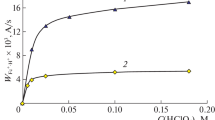Abstract
The metal complex in the FcCH2OH–HClO4–p-benzoquinone system is oxidized with p-benzoquinone as well as with the hydrogen ion as a result of its protonation. Involvement of the acid in both processes determines their influence of each of them on the rate of the other one. This fact has been confirmed by the obtained dependences of the rate of ferrocenium ions accumulation during protonation and oxidation of FcCH2OH on the reactants concentrations as well as by the derived kinetic equations of the processes. The degree of their mutual influence depends on the solvating properties of the solvents and the ratio of the starting concentrations of the metal complex and the acid, which affect the yield of the FcC+H2 carbocation and its ability to redox isomerism upon protonation of the metal complex.







Similar content being viewed by others
REFERENCES
Fomin, V.M. and Shirokov, A.E., Russ. J. Gen. Chem., 2009, vol. 89, no. 5, p. 928. https://doi.org/10.1134/S1070363209050119
Fomin, V.M., Orlova, E.A., and Zaitseva, K.S., Russ. J. Gen. Chem., 2014, vol. 84, no. 4, p. 722. https://doi.org/10.1134/S1070363214040215
Rinehart, K.L.Jr., Michejda, C.J., and Kittle, P.A., J. Am. Chem. Soc., 1959, vol. 81, p. 3162. https://doi.org/10.1021/ja01521a082
Fomin, V.M., Kochetkova, E.S., and Klyuchevskii, K.V., Russ. J. Gen. Chem., 2018, vol. 88, no. 5. P 948. https://doi.org/10.1134/S1070363218050183
Weinmayr, V., J. Am. Chem. Soc., 1955, vol. 77, p. 3009. https://doi.org/10.1021/ja01616a026
Nesmeyanov, A.N., Sazonova, V.A., Drozd, V.N., and Rodionova, N.A., Dokl. Akad. Nauk SSSR, 1965, vol. 160, no. 2, p. 355.
Mat’e, Zh. and Paniko, R., Kurs teoreticheskikh osnov organicheskoi khimii (Course of Theoretical Foundations of Organic Chemistry), Moscow: Mir, 1975, p. 530.
Bethel, D. and Gold, V., Carbonium Ions: An Introduction, London: Academic Press, 1967.
Clark, W.M., Oxidation-Reduction Potentials in Organic Systems, Baltimore: Williams and Wilkins, 1960.
Castagnola, M., Floris, B., and Illuminati, G., J. Organomet. Chem., 1973, vol. 60, no. 1, p. 17. https://doi.org/10.1016/S0022-328X(00)85420-0
Energii razryva khimicheskikh svyazei. Potentsialy ionizatsii i srodstvo k elektronu (Energies of Breaking Chemical Bonds. Ionization Potentials and Electron Affinity), Kondrat’ev, V.N., Ed., Moscow: Nauka, 1974, p. 333.
Bell, R.P., The Proton in Chemistry, Cornell University, 1958.
Fomin, V.M., Markin, A.V., and Shuklina, N.N., Russ. J. Gen. Chem., 2020, vol. 90, no. 6, p. 994. https://doi.org/10.31857/S0044460X20060091
Fomin, V.M., Shuklina, N.N., and Klimova, M.N., Russ. J. Phys. Chem., 2020, vol. 94, no. 9, p. 1791. https://doi.org/10.31857/S0044453720090071
Kondo, T., Yamamoto, K., and Kumada, M., J. Organomet. Chem., 1972, vol. 35, no. 1, p. 30. https://doi.org/10.1016/S0022-328X(00)86870-9
Kondo, T., Yamamoto, K., and Kumada, M., J. Organomet. Chem., 1973, vol. 61, no. 16, p. 1245. https://doi.org/10.1016/S0022-328X(00)86565-1
Ashkenazi, P. and Catz, M., Angew. Chem., 1972, vol. 84, p. 1106. https://doi.org/10.1002/ange.19720842210
Catz, M., Ashkenazi, P., Dani, S., Gottlieb, Y., J. Organomet. Chem., 1977, vol. 124, no. 1, p. 49. https://doi.org/10.1016/S0022-328X(00)90048-2
Bitterwolf, T.E. and Ling, A.C., J. Organomet. Chem., 1971, vol. 40, no. 1, p. 29. https://doi.org/10.1016/S0022-328X(00)86974-0
ACKNOWLEDGMENTS
The authors are grateful to Sinor company for the provided sample of ferrocenylmethanol.
Author information
Authors and Affiliations
Corresponding author
Ethics declarations
No conflict of interest was declared by the authors.
Additional information
Translated from Zhurnal Obshchei Khimii, 2021, Vol. 91, No. 7, pp. 1078–1091 https://doi.org/10.31857/S0044460X2107012X.
Rights and permissions
About this article
Cite this article
Fomin, V.M., Shuklina, N.N. Effect of Protonation on Ferrocenylmethanol Oxidation with p-Benzoquinone in the Presence of Perchloric Acid. Russ J Gen Chem 91, 1342–1353 (2021). https://doi.org/10.1134/S1070363221070124
Received:
Revised:
Accepted:
Published:
Issue Date:
DOI: https://doi.org/10.1134/S1070363221070124




